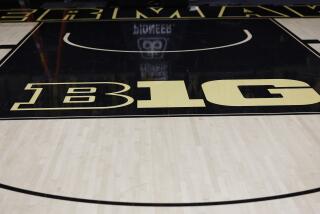Teams Selected Today for NCAA Tournament
KANSAS CITY, Mo. — By this afternoon, 29 entries in the NCAA Division I basketball tournament will have been decided in arenas from one end of the country to the other.
The other 35 will be decided in a hotel room.
Seven athletic directors, one conference commissioner and a faculty representative have converged on Kansas City with about 40 hours of meetings on their agenda.
That group will unveil the NCAA tournament’s 64-team bracket today, officially launching what has become one of the nation’s most anticipated sports events.
“This year will be very difficult,” said Dick Schultz, the Virginia athletic director and chairman of the men’s basketball committee. “And, unfortunately, we barely have enough time to get it done.”
The committee’s first chore is to choose the game officials--a difficult enough chore in itself. They then begin considering the teams.
“The process is such that, with the 64-team field, the first 50 teams are relatively easy,” Schultz said. “It’s the last 10-14 spots that are a very laborious task.
“It wouldn’t make a difference if we were picking 75 (teams), the last few teams, what with the parity there is today, are all very similar. You’d end up with the same situation regardless of the number. My first year on the committee we had 53 teams in the tournament and those last four or five teams were the hardest to choose.”
The NCAA Division I men’s basketball tournament has grown from an eight-team get-together that saw Oregon top Ohio State, 46-33, for the 1939 title to a 64-team extravaganza that will take three weeks to play and will pay $20,715,600 to the colleges represented. A trip to the Final Four March 29-31 in Dallas is worth a minimum of $835,300 to the schools.
With that much on the line, whatever decision the basketball committee makes is going to be unpopular with someone.
“The parity is so great that you really end up splitting hairs,” Schultz said. “But the bottom line--and we’ve been trying to impress this on coaches and athletic directors--is strength of schedule.
“When it comes down to those last few teams we look at how many times they played top 25 teams. How did they do? Was it home or away?
“If a team played a top 25 team on the road and played well, that counts for a lot.”
To help in the decision-making process, the NCAA provides its statistical analysis and three or four other computer services are also used. The committee also breaks into regional subcommittees, which ranks its area’s teams during the season.
Schultz said that after the 64 slots are filled, the committee begins to seed the teams and decide where they are going to play. This can be more unpopular than the selection process. Getting selected is no bargain if a team has to travel halfway across the country to face No. 1 Duke in the Blue Devils’ backyard in North Carolina.
The committee chairman said another fear is that one region will end up with the bulk of the talented teams. This is not easy considering five Top 10 teams come from states that border the Atlantic Ocean. In the Top 10, only Kansas is west of the Mississippi River and only four teams ranked 11-through-20 are from the West.
“We try to keep the teams in their natural regions, then the next closest,” Schultz said. “But with the number of schools we have in the East, and the quality of basketball in the East, a number of the teams end up going to other regions.”
While the basketball balance of power leans East, the basketball committee is much more balanced with two members from each region and one at-large member.
More to Read
Go beyond the scoreboard
Get the latest on L.A.'s teams in the daily Sports Report newsletter.
You may occasionally receive promotional content from the Los Angeles Times.










